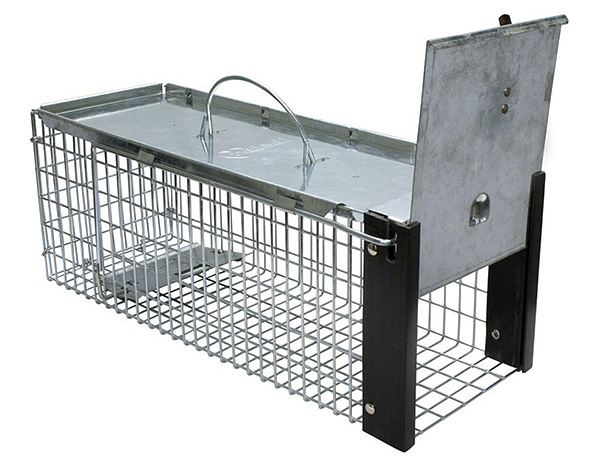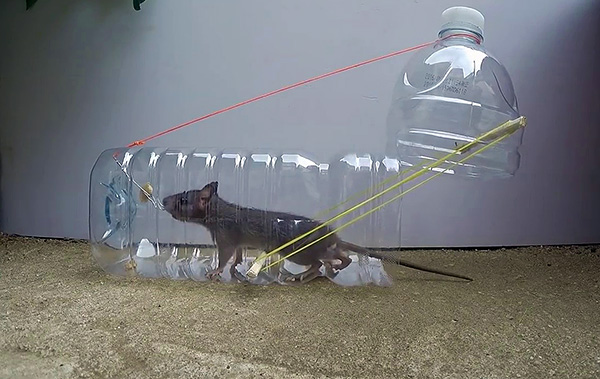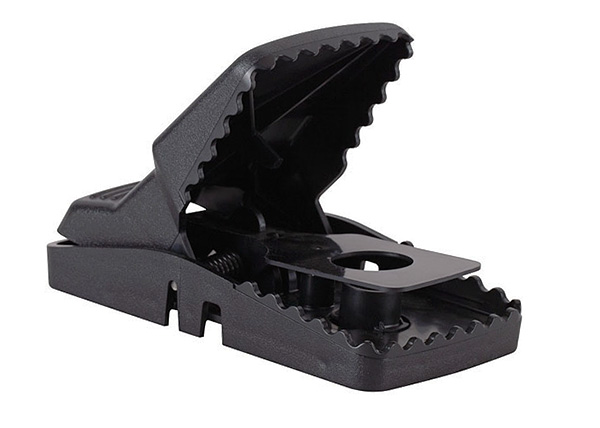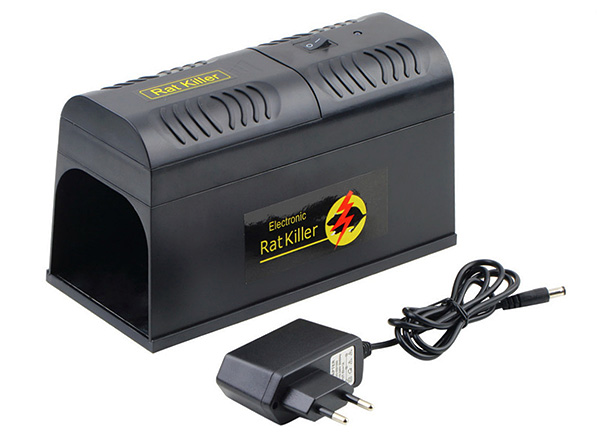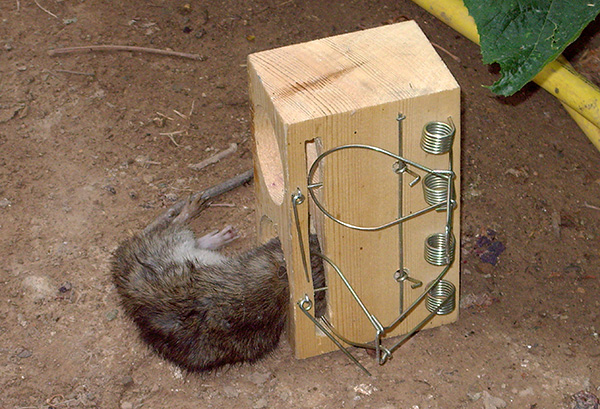
Practice shows that if a rat is wound up in the house, and even more so a few rats, then they themselves will not leave, and will constantly appear in the kitchen or in the basement, host in pantries, spoil food and leave fleas and their excrement in the room (often containing causative agents of dangerous diseases). In all such cases, it is necessary to catch the rat as soon as possible, and in order not to risk the health of the residents, it is advisable to start this business as soon as the first signs of the presence of a rodent in the house were discovered.
Fortunately, today there are many ways to get rid of rodents in the room quickly and without much hassle. And for this it’s not even necessary to buy a rat-trap of industrial production or dangerous poison - to catch a rat in a house is quite possible with a home-made device or in a way that does not require significant financial costs.
Next, we will consider several effective methods that allow you to catch a rat both at home and in the office, in the warehouse, in the barn or, for example, in the garage ...
All methods used to capture rats
There are several ways to catch a rat using a variety of means:
- Industrial live traps - devices that can be bought in stores or in the market, and which catch a rat without harming it. Their disadvantage is that in most cases they are rather bulky and relatively expensive tools. Their important advantage is complete safety for pets and people;

- Homemade live traps. Often, such tools appear when you try to copy a commercially available sample with your own hands, or to take its principle of action. For skilled craftsmen, such traps turn out to be even more effective and convenient than industrial ones, but, on the whole, their manufacture is rather laborious. Their only unambiguous advantage compared to industrial means is low cost (such a device can be made from improvised materials);

- Industrial mechanical traps - these tools simply kill the rat when triggered. They are usually inexpensive, easy to use, effective, but, unfortunately, dangerous for children and pets;

- Industrial electric rat traps that kill a rat with a high voltage current discharge (convenient, run on batteries, but quite expensive);

- Homemade mechanical traps - analogues of purchased products, the main advantage of which, again - price;

- With the help of pets - this method still does not lose its relevance, despite technological progress and the development of more and more new means of combating rats.

On a note
Also, sometimes they try to catch rats with glue (glue traps), but this method is not always effective. Rats - animals are relatively large, and glue is often not able to reliably keep them on the hunting surface. At the same time, glue can easily catch a mouse or a young rat.
In general, of all the above methods, the use of purchased rat traps-crushers (they are simply called mousetraps) is optimal. They are cheap enough, easy to use and, subject to the rules of use, relatively safe, and most importantly, with the right choice, the bait is very effective and allows you to catch a rat in almost any room - in a private house, in an apartment, in a barn, in a cellar.
However, the most “cunning” rats are not always able to be caught in such rat traps, as the animals feel danger and avoid them.
We catch the pest in the house alive: quickly and inexpensively
There are several options for quickly catching a rat in a house with homemade devices. Below are described the most effective of them, and repeatedly tested in practice.
Option 1:
- A saucepan (or other improvised container) is taken, a piece of sausage, lard or bread with vegetable oil is attached to the middle of its wall;
- The pan is turned upside down, placed on the floor;
- One edge of it rises, an unstable support is placed under it (for example, a nail or a lid from a can on a rib). The edge of the pan rests against the support.

When the rat gets under the pan behind the bait, it is highly likely to push the support, and as a result the pan will cover the rodent. Even if the rat is very neat and does not touch the support, the animal under the pan will press its front paws against its wall to get the bait, and still move the pan from the support.
Option 2 - allows you to catch a rat alive using an unstable bridge over a tank:
- A stool is placed next to an empty open barrel, on which a small board is placed, about half of which will hang over the neck of the barrel;
- At the very edge of this overhanging plank is a bait.
- The rat will try to get to the bait, the board with it will bend over and fall into the barrel.
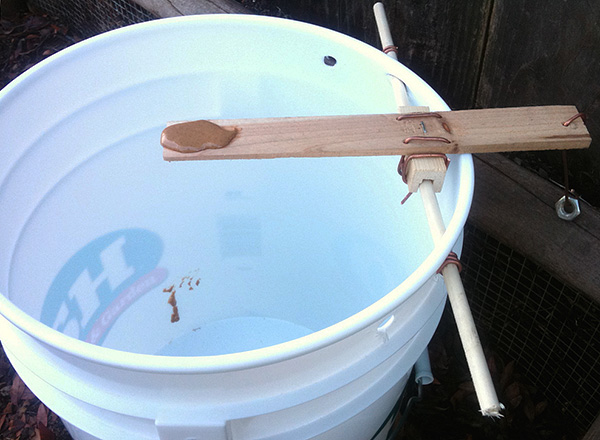
On a note
With a bucket, this principle would work, but a rat could jump out of a bucket. Sometimes the animal manages to get out even from a ten-liter bucket filled half with water.
Option 3 - the original trap from a plastic bottle:
In addition to the described traps being free of charge, their charm lies in complete safety - neither pets, nor children risk injury if they accidentally stumble upon such a device.
The main problem of the live trap is the need to decide what to do with the caught rat. It is good if a cat or dog lives in the house, which will gladly save the owner from this problem. If there is no such pet, then the rat will either have to kill on its own (which not everyone can do), or spend time and effort to release it away from home.
If you don’t want to do either, then you shouldn’t catch a rat alive.
On a note
An exception to this recommendation is cases when you need to catch a live escaped decorative rat. In this situation, live traps are ideal.
It is also important to remember that a living rat caught may well bite to the blood if you try to pull it out of the trap with your bare hands or in thin gloves. Such bites are quite painful, and, in addition, with a bite, the animal is able to infect a person with a dangerous infection. Therefore, all manipulations with the triggered live trap should be carried out in tight construction gloves.
Industrial live traps
A typical industrial live-trap rat trap is a small cage with an upward-opening door on a spring. When opening the door is fixed by a gatehouse, the lower part of which is inside the cage and has a loop. The bait is hung on an eyelet.
When the rat gets into the cage and begins to pull the bait, the gatehouse moves, releases the door, and it slams.

Such a triggering principle turned out to be the most effective for live traps, and therefore the vast majority of rat traps work just that way.
On a note
Professional rat traps, used by scientists to catch animals in the wild, work on the same principle. The only difference is that professional devices have a folding design and disassembled take up no more space than a compact tablet. This allows us to take several dozens of such traps on scientific expeditions. The most remarkable thing is that to catch a wild rat in such a device that seems to be unusual for it is not at all difficult - the animal has a stronger desire to enjoy the bait than fear of an unknown object.
The cage trap allows you to catch the rat very quickly: sometimes the pest is caught on the first night after installing the rat trap in the house. To obtain such a result, a rat trap is installed where the pest has been previously seen, or where the animals constantly leave traces of their activity - gnawed products, wool, excrement.
It is advisable not to enter the room where the trap is installed so that the animal gets out of the shelter as soon as possible and becomes interested in the bait.
On a note
An analogue of such a rat trap can be made with your own hands from a plastic bottle, in which the neck is not completely cut off, turning into a door. This door is lifted, fixed on an elastic band and a gatehouse with a bait is made. When the rat pulls the bait, the gum slams the door, blocking the animal in the bottle. The following video shows a corresponding example:
A standard live trap in the form of a cage costs about 400-500 rubles.
How to make an effective homemade rat trap
A simple home-made strangling rat trap can be made of a wooden bar with sawn “tunnels”, in the depths of which the bait is laid. A spring with a wire loop is fastened above the bar at the very entrance to the tunnel.
In the middle of the tunnel, it is drilled through a hole at the top and bottom. Here a thread is drawn, which is tied over a spring and presses it to the bar, and the loop coincides with the passage in the tunnel itself. When a rat tries to get close to the bait, it stumbles upon a thread that interferes with it. The animal cuts the thread, the spring unclenches, tightens the loop on the body of the animal and strangles it:
The advantage of such a rat trap is its safety - neither a cat nor a dog can lower the spring. Its minus is the laboriousness of manufacturing.
In general, traps are good in that they solve two problems for a person at once: they catch a rat and kill it. Puzzling over what to do with the caught rat, no longer have to.
You can also make another version of a suffocating trap for catching a rat with your own hands - from a cable tie:
Purchased traps, their advantages and disadvantages
Industrial rat traps are inexpensive, easy to use, but quite dangerous to handle.
The most commonly used rat trap crush. In them, the working mechanism has a powerful spring that can break the paw of a cat or dog, and can even break a finger of a child. Therefore, it is advisable to use such tools only in non-residential premises - underground, in the attic, in the garage, in the car or in the barn, but it is undesirable to use them in the apartment, in the kitchen or in the toilet of a private house, where pets and children can find a trap.
On a note
If it is necessary to use it in residential premises, such rat traps are installed in special containers with openings into which only rats can climb (these containers are called bait stations).
Traps should not be used for rats outdoors or in the wild, where they can kill birds or useful mammals.
The photo below shows how much the industrial traps are:

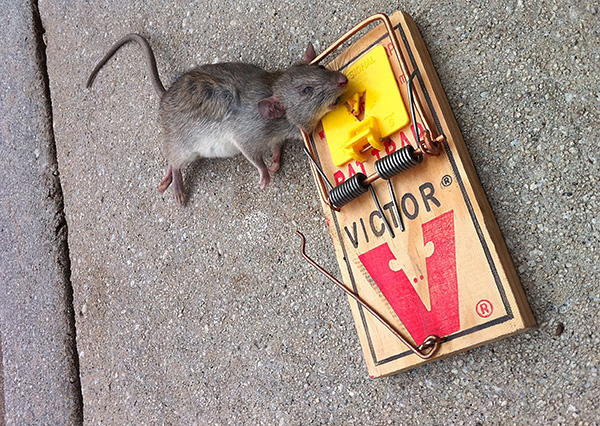

About electric traps for rats and mice and the feasibility of their use at home
The principle of operation of the electric rat trap is that the rat climbs into it, attracted by the smell of the bait, and when it touches the metal electrode, an electric circuit is closed on the animal - an electric shock occurs. The video below shows an example of the operation of such a device:
Electric rat traps are highly efficient and easy to use, but they have a serious drawback - on average, such devices are much more expensive than a standard rat trap (moreover, some models cost tens of times more).
In general, such a device is well suited for those who want to destroy all rodents in the room without blood and without the use of poison. Read more about electric rat traps in a separate article: Using electric rat traps to control rodents
What bait to put in a rat trap to surely catch a pest
To catch a rat, it is important not only to use an effective rat trap, but also to choose the right bait.

First of all, it is useful to remember that rats prefer animal feed - for example, they have a greater passion for meat and lard than mice. Therefore, it will be easier to catch a rat if one of the following products is put in a trap:
- Salo (ideally a slightly tinged match);
- Smoked sausage or meat product with a pronounced smell;
- Minced meat (ideally with onions);
- A piece of fish.
With the successful use of any bait for some time, the most cautious and "cunning" rats may cease to show interest in it. Therefore, periodically it makes sense to change the bait.
Cat or dog as a universal rat fighter
As a rule, a good cat trap catches rats more efficiently than traps, and the use of such an assistant does not require additional effort from a person. If you specifically do not have such a cat, and there are not many rats in the house, then it makes sense to ask a cat or a cat from someone you know. Running a cat in the basement or in the attic, hungry, quickly "figure out" your problem.

On a note
Catch an earthen rat in an open area (not in the house) can a dog of a normal breed - yagd terrier, welsh terrier, fox terrier, dachshund. Interestingly, in these animals the hunting instinct remains in the blood, they may not even eat prey, but they will certainly catch it if they notice it.
It is only important to remember that if you rely on domestic rat-catchers, then rats should never be tried to poison. Many cases are known when a cat or dog caught a poisoned rat, and then they were treated for a long time in a veterinary clinic, and it was not always possible to save the animals.
Therefore, if you want the cat to catch a rat, make sure that its prey is harmless to him.
Flayer methods of catching rodents in the house
Also popularly known are methods of capturing rats, which cannot be called otherwise savage.
For example, sometimes rats are trying to offer a bait with fishing hooks hidden in it on a fishing line. The effectiveness of such tackle is small, because the rat gnaws off small pieces from food and finds a hook, but in those cases when it nevertheless swallows it, it experiences terrible torment before its death.
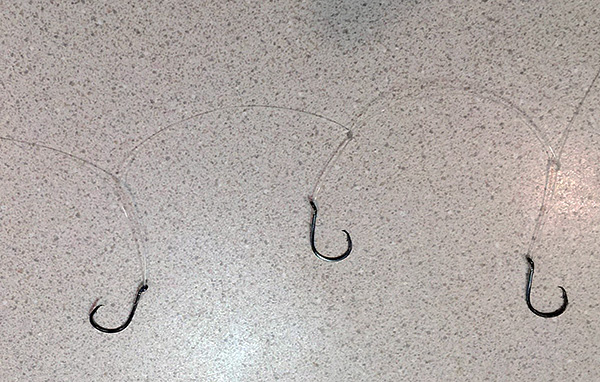
On a note
The aforementioned method of catching rats for glue also belongs to the animal husbandry, although not everyone thinks about it. When the animal sticks to the site with glue, it then dies of thirst for several days. It’s much easier and more humane to just catch a rat in a trap, which will kill it almost instantly.
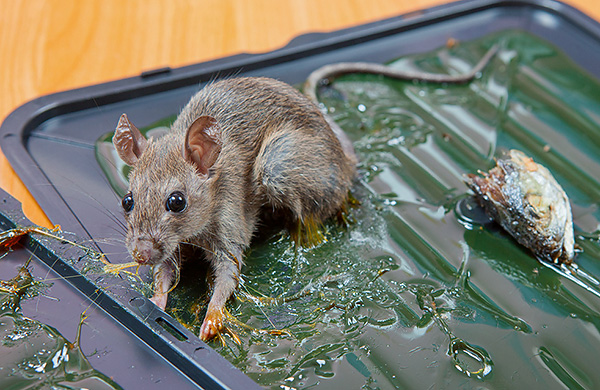
And finally, if you can’t catch a very cunning rat at all by any means, it makes sense to contact the rat and mouse trapping service (the deratization service) for help. Such companies usually have a very extensive arsenal of tools that allows you to quickly and efficiently destroy all rodents in the house, even in the most advanced and difficult cases.
If you have experience in capturing rats in the house yourself, be sure to share the information by leaving your review at the bottom of this page.
Not all cats can control a rat ...

